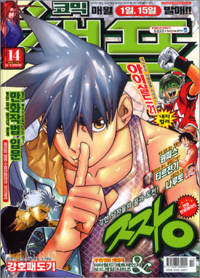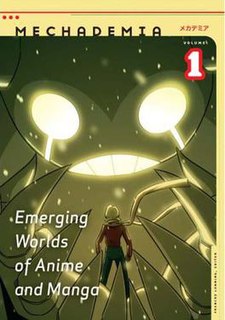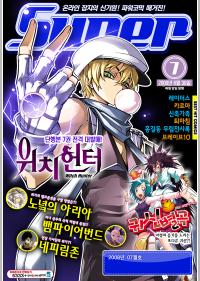 W
WAnime Insider was a monthly magazine published by Wizard Entertainment, consisting of news and entertainment pieces relating to the Japanese anime and manga subculture. In its earliest incarnation it was published from Fall 2001 till Fall 2002 as a series of quarterly specials under the title Anime Invasion, then became a bi-monthly magazine in November 2002, and was renamed Anime Insider in April 2003. The magazine was changed to a monthly release schedule in July 2005, which remained its current cycle until it ceased publication in 2009.
 W
WAnimerica was a monthly magazine published by Viz Media containing news, feature articles, and reviews on manga, anime, and related media, as well as a section that serialized manga published by Viz. After an initial November 1992 preview issue, Animerica's first regular issue was released in February of 1993 with a March 1993 cover date. In 1998, Animerica Extra was launched as a separate manga anthology magazine which eventually focused specifically on shōjo titles. It was canceled in 2004.
 W
WAnimerica Extra was a monthly manga magazine published in by Viz Media. Established as a companion to the anime news and review magazine Animerica, Animerica Extra primarily published English-language translations of Japanese manga. The magazine shifted towards publishing shōjo manga in 2003, before ceasing publication in 2004.
 W
WBanzai!, officially stylized BANZAI!, is a discontinued shōnen manga anthology that was published in Germany by Carlsen Verlag, from November 2001 to December 2005. It debuted in November 2001 as a German language adaptation of the popular Japanese manga anthology Weekly Shōnen Jump, published by Shueisha. In addition to various series from Weekly Shōnen Jump, the magazine serialized some original German manga-influenced comics, including Crewman 3. Issues also included educational articles to teach readers Japanese and columns with news updates on anime and manga series. Series published in the magazine were also published in tankōbon volumes under the Banzai! präsentiert and the highly popular series under the Best of Banzai! label. The name Banzai! came from the transliteration of 10,000 years, a traditional Japanese exclamation.
 W
WComic Champ is a biweekly magazine published in South Korea by Daiwon C.I.. It specializes in serializations of domestic Korean and imported Japanese comics. Titles serialized in Comic Champ are collected into volumes and published under the Champ Comics imprint.
 W
WGaro (ガロ) was a monthly manga anthology magazine in Japan, founded in 1964 by Katsuichi Nagai. It specialized in alternative and avant-garde manga.
Manga Force: The Ultimate Collection was a UK based anime magazine published by Hachette Partworks in association with Manga Entertainment Ltd. It was available in several markets such as Ireland, Australia, New Zealand, South Africa, Malta, Malaysia, and Singapore and was distributed by Marketforce in the United Kingdom. Produced by Creative Plus Publishing Ltd, the magazine mistakenly refers to anime as manga, which is common for a Manga Entertainment publication. and can lead to confusion to those discovering Japanese animation.
 W
WMechademia: Second Arc is a biannual peer-reviewed academic journal in English about Japanese popular culture products and fan practices. It is published by the University of Minnesota Press and the editor-in-chief is Frenchy Lunning. Mechademia has also held an annual conference since 2001.
 W
WMyM was an 84-page monthly entertainment magazine published in the United Kingdom by the MCM Expo Group. Originally focusing on various aspects of Japanese pop culture, including anime, manga, Japanese cinema and music, cosplay, lolita fashion and video games, it later broadened its reach to become a fully rounded entertainment magazine, including features and interviews on mainstream films, television programmes, comics, books and music.
 W
WNEO is a monthly magazine published in the United Kingdom and Ireland by Uncooked Media. The magazine focuses on various aspects of East Asian entertainment, such as Japanese anime and manga, East Asian cinema, cosplay, music, and more.
 W
WNewtype is a monthly magazine publication originating from Japan, covering anime. It was launched by publishing company Kadokawa Shoten on March 8, 1985 with its April issue, and has since seen regular release on the 10th of every month in its home country. Newtype Korea is published in Korea. Spin-off publications of Newtype also exist in Japan, such as Newtype Hero/Newtype the Live and NewWORDS, as well as numerous limited-run versions.
Otaku USA is a bimonthly magazine published by Sovereign Media, which covers various elements of the "otaku" lifestyle from an American perspective. The issues were accompanied by a DVD featuring three anime episodes but as of 2009 the DVD feature was dropped and the double sided poster feature of the Magazine was also dropped starting with the February 2010 issue.
 W
WPiQ was a short-lived American popular culture magazine that was published by PiQ, LLC, a subsidiary of A.D. Vision, from March through July 2008. Launched as a replacement for the magazine Newtype USA, which was discontinued in February 2008, PiQ went beyond anime and manga to include coverage on video games, popular American comics, and television series.
 W
WProtoculture Addicts was a Canadian-based anime and manga themed magazine published by Protoculture Inc., an Anime News Network company. The term "Protoculture Addicts" was also used by the Zentradi to refer to all the races that have been in contact with Protoculture.
 W
WPulp was an American manga magazine and literary imprint published by Viz Media from 1997 to 2002. The magazine, which primarily published English-language translations of seinen manga, was the first English-language magazine that published manga aimed at an adult audience.
 W
WRaijin Comics is a discontinued manga anthology published from 2002 until 2004 in North America by the now-defunct Gutsoon! Entertainment and largely backed by the Sega Corporation at its inception. The collected volumes of Raijin Comics titles were published under the Raijin Graphic Novels imprint. The magazine was aimed at mature readers.
 W
WShojo Beat is a shōjo manga magazine formerly published in North America by Viz Media. Launched in June 2005 as a sister magazine for Shonen Jump, it featured serialized chapters from six manga series, as well as articles on Japanese culture, manga, anime, fashion and beauty. After its initial launch, Shojo Beat underwent two redesigns, becoming the first English anthology to use the cyan and magenta ink tones common to Japanese manga anthologies. Viz launched a related imprint of the same name for female-oriented manga, light novels and anime.
 W
WShonen Jump, officially stylized SHONEN JUMP and abbreviated SJ, was a shōnen manga anthology published in North America by Viz Media. It debuted in November 2002 with the first issue having a January 2003 cover date. Based on Shueisha's popular Japanese magazine Weekly Shōnen Jump, Shonen Jump is retooled for English readers and the American audience, including changing it from a weekly publication to a monthly one. It features serialized chapters from four manga series, and articles on Japanese language and culture, as well as manga, anime, video games, and figurines. Prior to the magazine's launch, Viz launched an extensive marketing campaign to promote it and help it succeed where previous manga anthologies published in North America had failed. Shueisha purchased an equity interest in Viz to help fund the venture, and Cartoon Network, Suncoast, and Diamond Distributors became promotional partners in the magazine.
 W
WShōnen Sekai , is one of the first shōnen magazines published by Hakubunkan specializing in children's literature, published from 1895 to 1914. Shōnen Sekai was created as a part of many magazine created by Hakubunkan that would connect with many different parts of society in Japan. Sazanami Iwaya created the Shōnen Sekai magazine after he wrote Koganemaru a modern piece of children's literature. After Japan had a war with Russia, a female adaptation of Shōnen Sekai was created named Shōjo Sekai. Also some children's books were translated to Japanese and published in Shōnen Sekai. The magazine had many features too, such as sugoroku boards and baseball cards. Shōnen Sekai was mentioned in many American books but no series were actually translated.
 W
WSuper Champ (수퍼챔프) is a South Korean magazine produced by Daiwon C.I.. It is available only online, and specializes in serializing domestic and imported comics. Its first issue was published in 2006, and it is released on the last day of each month. Following publication in Super Champ, individual series are later collected into volumes and published in hard copy form under the Super Champ Comics imprint.
 W
WSuper Play was a British Super Nintendo Entertainment System (SNES) magazine which ran from 1 October 1992 to September 1996.
 W
WWaneko is a Polish manga publisher, located in Warsaw, Poland. The founders of Waneko are Aleksandra Watanuki, Martyna Taniguchi and Kenichiro Watanuki.
 W
WWeekly Shonen Jump was a digital shōnen manga anthology published in North America by Viz Media, and the successor to their monthly print anthology Shonen Jump. It began serialization on January 30, 2012 as Weekly Shonen Jump Alpha, with two free preview issues published in the buildup to its launch. Based on Shueisha's popular Japanese magazine of the same name, Weekly Shonen Jump was an attempt to provide English-speaking readers with easily accessible, affordable, and officially licensed editions of the latest installments of popular Shōnen Jump manga soon after their publication in Japan, as an alternative to popular bootleg scanlation services which were illegal and often poorly translated. It attempts to copy the Japanese magazine.
 W
WYen Plus was an American monthly anthology magazine of Japanese manga, Korean manhwa, and original English-language (OEL) manga published by Yen Press.